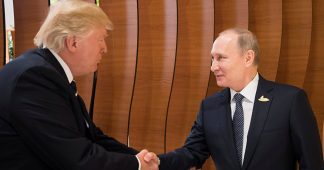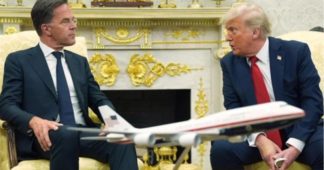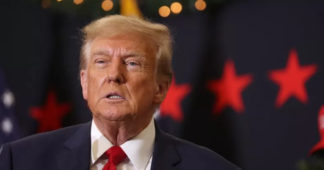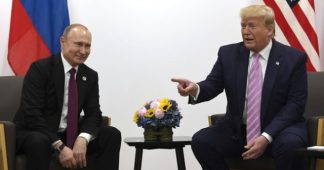The US is shifting the financial burden of the proxy war onto Europe and projecting an image of disengagement — while remaining firmly in control of Ukraine’s military operations
By Roberto Iannuzzi,
originally published in Italian on his Substack
Jul 24, 2025
Those who still held out hope that Donald Trump would resolve the Ukraine conflict through diplomacy have likely abandoned it in recent days.
A real negotiation between Russia and Ukraine never took off, and the Trump administration’s bizarre attempt at mediation (the United States being a co-belligerent rather than an impartial arbiter) was ineffective from the outset. But the events of recent days likely mark a definitive turning point.
After a brief pause in arms shipments to Kyiv — apparently due to dwindling US stockpiles — on July 7, Trump announced the resumption of military aid, justifying it with intensified Russian attacks and Ukraine’s urgent need for air defense systems.
The administration thus decided to draw $300 million worth of weapons from Pentagon stockpiles under the Presidential Drawdown Authority (PDA) and send them to Kyiv.
It is the first time in his second term that Trump has used the PDA, a mechanism routinely employed by his predecessor, Joe Biden.
The decision coincided with a shift in tone by the US president, who for the first time used very harsh language towards Russian president Vladimir Putin, accusing him of “killing a lot of people” and of failing to back up his words with concrete actions.
Trump and the hardliners
Although the American president has long been known for sudden U-turns and abrupt mood swings, his changed approach toward Moscow in the following days appeared to be something less improvised.
This shift in stance fits into the context of immense pressure from the media and political establishment to push the president back into the path charted by Biden — namely, providing Ukraine with abundant financial and military support.
Republican hawks and neoconservatives, who since Trump’s return to the White House have worked to marginalise the “isolationist” tendencies of the MAGA movement, are determined — riding the wave of the military strike on Iran, which they have heralded as a “success” — to reignite the confrontation with Russia.
The leaders of the UK, France, and Germany, as well as top EU officials, are likewise pressing for the continuation of the war. German Chancellor Friedrich Merz declared that the diplomatic tools to resolve the conflict in Ukraine have now been “exhausted”.
Until now, Trump had resisted such pressures. Convinced that Kyiv could not win, he had repeatedly labeled the conflict “Biden’s war” to distance himself from his predecessor and seek a US disengagement from Europe in order to refocus attention on the Pacific and China’s rise.
However, this recent shift in direction suggests that the war in Ukraine may soon become “Trump’s war”.
NATO steps in
On July 14, during a meeting at the White House with NATO Secretary General Mark Rutte, the American president unveiled an agreement with the Atlantic Alliance to send large quantities of weapons to Ukraine. He also threatened Moscow with severe secondary sanctions on its oil exports if it does not accept a negotiated settlement of the conflict within 50 days.
According to some US sources, the deal with NATO is worth an estimated $10 billion, though the timeframe remains unclear.
Although this plan was discussed at last month’s NATO summit in The Hague, its origins go back to the period immediately following Trump’s presidential victory, when European leaders began considering a mechanism that would allow weapons deliveries to Kyiv to continue even in the event of a withdrawal by the newly elected president.
As agreed, it would not be NATO itself sending the weapons to Kyiv. Rather, the Alliance would act as a logistical hub for US-purchased arms, coordinating deliveries by individual member states.
The arms transfer mechanism to Ukraine may involve either weapons purchased directly from the US, or those already held by European countries, which would then be replenished through new orders placed with American manufacturers.
By selling weapons to the Europeans instead of delivering them directly to Kyiv, Trump hopes to deflect accusations — likely to come from his base — that he is reneging on his promise to exit the Ukraine conflict.
Moreover, the implementation of the agreement will result in new profits for the US arms industry.
More appearance than substance
It is unclear, however, what weapons and ammunition will actually reach Kyiv’s hands, nor which European countries will genuinely take part in the scheme. Hungary has already declared that it has no intention of participating, and shortly after, France, Italy and the Czech Republic followed suit.
Moreover, after three years of war, neither the US nor European countries have large stockpiles of weapons and ammunition left to provide. They can only purchase arms still in production — but those will take time to reach the Ukrainian battlefield.
Neither the American nor the European arms industries can keep up with the demand coming from Ukraine and other war zones, and neither is capable of competing with Russia’s production capacity.
A textbook example of this is the American-made Patriot air defense batteries. There are currently 18 Patriot batteries in Europe, which cannot be sent to Kyiv without leaving the continent exposed.
Germany, which currently owns six of them, has confirmed plans to purchase two new batteries from the US to send to Ukraine — but this will take months.
According to a Guardian investigation, even the US has seen its reserves of Patriot missiles drop to critical levels, currently possessing only 25% of the interceptors required by the Pentagon’s military planning.
Lockheed Martin, which manufactures them, had announced plans to increase production from 500 to 600 units in 2025. However, according to some estimates, Russia produces around 750 ballistic missiles per year. Given that multiple interceptors are needed to take down a single missile, it becomes clear that US production is wholly insufficient.
Despite bold statements like that of Republican Senator Lindsey Graham — who claimed “You’ll see weapons [flowing to Ukraine] at a record level” — it is therefore likely that the quantities arriving in Kyiv will not be enough to significantly alter the course of the war.
The blunt weapon of sanctions
Similarly, there is reason to doubt that the threat of additional tariffs or sanctions will alter Russia’s strategic calculations.
Potential US tariffs on Russian exports would be negligible, as such exports total no more than $3 billion. As for possible secondary sanctions on Russian oil and other exports, these would primarily impact Moscow’s trade partners — such as China, India and Europe.
Russia would certainly feel the effects, but the costs would be borne by everyone — especially some of Washington’s own allies — due to the repercussions on global energy markets.
Moscow has also developed considerable skill in evading Western economic pressure, and the Russian economy has shown remarkable resilience in the face of such sanctions.
Confirming this, following Trump’s announcement of possible new sanctions, the Russian stock market rose by nearly 3%, suggesting that Russian investors are not particularly alarmed.
An ineffective negotiation approach
Trump’s tougher rhetoric toward Russia seems to stem from “disappointment” over Moscow’s refusal to negotiate under Western terms — which require a ceasefire as a precondition for any dialogue.
But it was always clear that the Kremlin would not agree to sit at the negotiating table without any assurance that the deeper causes of the conflict would be addressed, while the West continued to arm Ukraine.
The prospect of a “frozen conflict” — which would allow Kyiv to regroup and rearm in preparation for another round of fighting — was unacceptable to Moscow.
For its part, the Trump administration has not taken even the most basic steps toward a “normalisation” of relations with Moscow — such as returning seized diplomatic properties, resuming flights between the two capitals or even simply appointing a new ambassador to Russia.
Why Washington cannot disengage
On the other hand, the idea that Europeans might replace the US in supporting Kyiv has always appeared problematic.
Ukraine has been supplied with the full range of American weapons systems — air defense systems like Patriot, NASAMS and HAWK; artillery systems such as howitzers, mortars and HIMARS; armored vehicles like the Bradley and Stryker, and even Abrams tanks.
Modern military equipment is highly sophisticated and complex, requiring hundreds of subcomponents and software elements. These systems depend on data provided by manufacturers to function — data that is proprietary and cannot be shared with third parties.
Moreover, Ukraine depends on the US not only for weapons but also for logistics and intelligence, particularly in identifying and selecting targets. In Ukraine, the United States is “an integral part of the kill chain”, as The New York Times has reported.
European countries are neither able to adequately replace US weapons systems, nor can they take over the American role in logistics and intelligence.
They lack both satellite surveillance capacity and the cargo planes and transport ships needed to move military matériel.
For all of these functions, Europe depends on the US — a dependency Washington has actively encouraged over the years, precisely to prevent the continent from developing greater strategic autonomy.
But this fact also makes it virtually impossible for the US to disengage from the European theatre (and especially the Ukrainian one) in the short to medium term — unless Washington is willing to give up the new “Iron Curtain” it has so meticulously constructed in Europe in recent years.
This is why the idea of allowing European countries to purchase American military equipment to transfer to Ukraine was introduced — an idea embraced by Trump from the earliest days of his presidency.
It is a system that allows the US to shift the financial burden of the war onto Europe while projecting an image of disengagement that is, in reality, merely superficial (and which does nothing to resolve the underlying issues of logistics and intelligence).
The growing risk of provocations
As we’ve seen, the shipment of new weapons is unlikely to significantly change the course of the war in Ukraine, due to the production limitations of the US and European arms industries.
But that doesn’t mean Trump’s policy shift comes without risks — particularly the risk of escalating the conflict or provoking new incidents against Moscow.
The danger of “horizontal escalation” must also not be underestimated — that is, the spread of the conflict to other fronts, from the Baltics to the Caucasus and Central Asia.
Both the Financial Times and the Washington Post reported in recent days on a phone call between Trump and Ukrainian President Volodymyr Zelensky, during which Trump allegedly asked whether Ukraine was capable of striking Moscow — and even St. Petersburg.
Zelensky reportedly responded that the Ukrainian armed forces could indeed hit those Russian cities if the US provided the necessary weapons.
According to the Financial Times, Trump seemed open to the idea of supplying Ukraine with long-range weapons in order to “make them [Russians] feel the pain” and force them to the negotiating table.
American officials are even said to have given Zelensky a list of long-range weapons that the US might eventually supply.
In subsequent statements — while not denying the phone call — Trump claimed he does not intend to provide long-range weapons to Kyiv and stated that Zelensky “should not strike Moscow”.
Referring to the phone call, a White House official told the BBC that Trump was “merely asking a question, not encouraging further killing”, and added that the president “is working tirelessly to stop the killing and end this war”.
Nevertheless, Washington Post columnist David Ignatius — closely tied to US intelligence circles — cited sources suggesting that Trump’s policy shift might include authorising Ukraine to use the 18 ATACMS missiles it still possesses to strike deep inside Russian territory. These missiles have a range of 300 kilometers.
The delivery of additional ATACMS missiles to Ukraine has also not been ruled out. Even then, the numbers would likely be limited, as these missiles are scarce even in US arsenals.
Still, such strikes by Kyiv — while unlikely to shift the strategic balance — could be devastating and highly provocative.
According to Ignatius, the Trump administration even considered sending Tomahawk cruise missiles (which have a range of over 1,000 km), the same type used in the strike on nuclear facilities in Isfahan, Iran. For now, however, that idea has reportedly been shelved.
It’s difficult to assess the reliability of such “leaks”. One must remember that both Ignatius and the Washington Post are firmly in the “hawkish” camp when it comes to confronting Moscow.
Such reports could be part of a propaganda campaign aimed at intimidating Russia and bolstering the interventionist faction in Washington.
Still, the risk of provocations — like Ukraine’s “Spider Web” operation on June 1, which targeted Russia’s strategic bombers at bases across its territory — should not be taken lightly.
Following the strike on Iran, a bipartisan “war party” appears to be gaining momentum in Washington, one that increasingly believes that international issues can be resolved through the use of force.
Trump will inevitably have to contend with the isolationist wing of the movement that supports him.
But according to Ignatius, Trump himself was reportedly impressed by the performance of B-2 bombers in the strike on Iran’s nuclear facilities and has come to believe that “greater pressure” must be brought to bear on Russian President Vladimir Putin.
Also read Our War President
We remind our readers that publication of articles on our site does not mean that we agree with what is written. Our policy is to publish anything which we consider of interest, so as to assist our readers in forming their opinions. Sometimes we even publish articles with which we totally disagree, since we believe it is important for our readers to be informed on as wide a spectrum of views as possible.











